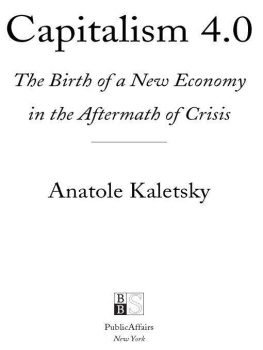The Beauty of Capitalism
And why it thrives despite its many critics
Antonio J. Marques Mendes
Copyright 2016 A. J. Marques Mendes
All rights reserved.
Published by SADIF Investment Analytics, lhavo, Portugal
ISBN : 10: 1500120782
ISBN-13: 978-1500120788
Library of Congress Control Number: 2016902828
LCCN Imprint Name: CreateSpace Independent Publishing Platform, North Charleston, SC
Cover design by Fabio Soares, based on a photo by Francisco Carrola. The front picture shows the Covo de Ferro dam at Serra da Estrela, in Portugal. My father was a teenager when he worked there taking measurements for its foundations. The dam was built in the 1930s as part of an hydroelectric power system promoted by Alfredo Santos Marques, a remarkable priest and entrepreneur.
To my late father, whose life taught me many economic lessons
CONTENTS
ACKNOWLEDGMENTS
The book would not be possible without the readers of my blog on the Six Pillars of Human Happiness. Special thanks are due to Prof. Tony Thirlwall for reading the manuscript and writing the kind review published on the back cover of the book. Likewise, I would like to thank Fbio Soares and Francisco Carrola for the cover design and Dinis Santos for preparing the list of references. Finally, I would like to thank my family, friends, and colleagues for their encouraging comments and patience with my absences. As a matter of factand to keep up with traditionlet me remind the reader that I am the person responsible for any errors, misconceptions, or omissions in this book.
INTRODUCTION
In February 2010, when I started my blog on the Six Pillars for the Good of Humanity ( http://marques-mendes.blogspot.com/ ), market capitalism was an immediate choice as one of those pillars. I had both theoretical and personal reasons for that.
At the personal level, in the 1970s, I had matured from a left-wing youngster into a center-right adult, who ended up in a faculty that has remained stubbornly leftist. For a long time, I wasnt interested in the university politics because I believed that the more my colleagues tried to indoctrinate the students on anticapitalism, the more they would turn procapitalist after facing real life outside the university. Yet I grew increasingly fed up with listening to so many anticapitalist discourses in many public ceremonies and felt the need to distance myself from such attacks. This anticapitalist stance is not specific to my university. A search on Amazon for books on capitalism showed that 75 percent of all books were anticapitalism.
Nevertheless, the theoretical reasons were paramount to my choicenamely, to try to understand why an economic system that had been unquestionably so successful was so disliked. Being an economist, I was naturally drawn into analyzing why capitalism was indispensable for a prosperous economy and into studying what types of capitalism were more efficient, so my second post (reproduced in Chapter 3) immediately raised the question of how close we were to the market capitalism ideal.
Under this topic, I have written many posts dealing with economic and financial issues. These have been mingled with other political and scientific topics. However, given the complexity of some of the issues, I felt that readers would benefit from having a book that would organize such issues in a logical sequence.
This book is the result of such an enterprise. Its sections are all short expositions using a nontechnical style. Their concision may at times seem inappropriate, given the complexity of the issues. In particular, a number of essays present new ideas and models that should have been published in refereed academic journals.
The book is divided in three partsfoundations, supremacy, and challenges.
The foundations of capitalism (Chapters 1 through 4) start by defining capitalism. This is followed by an overview of its six fundamental institutions, a clarification of the main types of capitalism, and an examination of the roots of anticapitalism ideologies.
The supremacy of capitalism (Chapters 5 through 8) is shown to be not only economic but also social: a major driver of freedom, democracy, and equality, which so often have been invoked to denigrate capitalism.
Finally, the challenges to capitalism (Chapters 9 through 14) discuss the threats internal to market capitalism, with a special emphasis on those related to a growing financialization of the economy and a perverse evolution of finance theory. This section also includes an examination of how regulation may interfere with capitalism and a clarification of what one can and cannot expect from capitalism. This part concludes with a speculative analysis of how capitalism may end.
The book was written for a wide audience, but occasionally, it inevitably suffers from a professional biasnamely, an excessive treatment of financial issues. My suggestion to those not interested in such issues is to skip them.
In general, the ideas expressed are personal reflections that I would like to share with the reader in a thought-provoking exercise.
1. What Is Capitalism?
Since the word capitalism is so often misused, I devote the first three chapters of this book to explaining what capitalism is, what its fundamental pillars are, and how to differentiate the various types of capitalism. A proper understanding requires that we begin with a brief history of economic systems, along with the highlighting of the main developments that proceeded each. Next, because capitalism changed traditional social structures, we explain how nobility and clergy adapted to the new economic systems.
And, because many alternative economic systems were tried in many countries, I examine why these alternatives invariably failed. Since the capitalist model cannot be applied to all economic activities, we discuss how the various modes of production coexist. This is followed by an assessment of how much capitalism is needed for a country to be considered predominantly capitalist. Finally, we clarify the roles of the state and voluntary sectors in facilitating the understanding of the basic pillars of capitalism.
A Brief History of Economic Systems
Economic systems are characterized by a set of rules defining the relationship between interacting economic agents. The organization of economic activities is not separate from the political and social institutions adopted by the groups carrying out such activities. Thus, we may identify many economic systems across the globe and throughout human history.
However, by considering only broad differentiating factors, we may limit our history to five main economic systemsthe gathering and hunting economy, the predatory and slave economy, the medieval serfdom system, centrally planned economies, and capitalism or a free market system.
With the exception of the centrally planned systems (fascism, national socialism, and communism), which were driven by a precedent ideology, all of the systems evolved more or less spontaneously after long periods of gestation. In this brief history of these five major economic systems, I highlight their main distinguishing features in terms of division of labor, property rights, income distribution, and capital accumulation.
Our oldest ancestors ( Homo sapiens ) appeared as a distinct species some two hundred to five hundred thousand years ago; they organized themselves in small groups, mostly made up of family members. They were initially roving hunters, only settling down to farming between ten and fifty thousand years ago. At this stage, their level of organization was much more developed. It included a clear division of labor between male (hunter) and female (farmer); a division of property rights between common and family property; and an acceleration in the capital accumulation of durable goods including both lodging and hunting/domestic tools and nonessentials, such as jewelry and cultural and religious artifacts.









